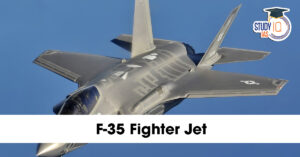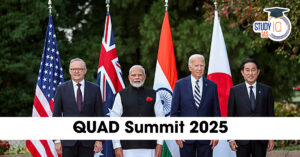Table of Contents
NISAR Mission
Context: The NASA-ISRO Synthetic Aperture Radar (NISAR) Mission is on track for an “early 2024” launch.
About NISAR Mission
- Joint NASA-ISRO Low Earth Orbit Observatory: NISAR is a collaborative project between NASA and ISRO, positioned in Low Earth Orbit (LEO).
- SUV-Sized Satellite Specifications: The satellite is comparable in size to an SUV and has a weight of 2,800 kilograms.
- Dual-Frequency Imaging Radar: Equipped with both L-band and S-band synthetic aperture radar (SAR) instruments, NISAR functions as a dual-frequency imaging radar satellite.
- Pioneering Dual-Radar Frequency Mission: This is the first satellite mission to utilise two distinct radar frequencies, L-band and S-band, for monitoring changes on Earth’s surface.
- Cloud-Penetrating SAR Technology: The SAR technology on NISAR can penetrate cloud cover and collect data both day and night, regardless of weather conditions.
- Contribution of NASA and ISRO: NASA has contributed the L-band radar, GPS, data storage, and payload data subsystem, while ISRO has provided the S-band radar, GSLV launch system, and the spacecraft itself.
- Innovative Antenna Design: The satellite includes a large 39-foot antenna reflector, made of gold-plated wire mesh, which focuses radar signals for both emission and reception.
- Mission Goals: NISAR aims to monitor Earth’s ecosystems, surfaces, and ice masses, offering insights into biomass, natural hazards, sea level changes, and groundwater levels.
- Regular Global Observation Schedule: The satellite will observe the Earth’s land and ice-covered surfaces globally every 12 days, covering both ascending and descending passes.
We’re now on WhatsApp. Click to Join
Mosquitofish
Context: Recently officials in Visakhapatnam are set to release an additional six lakh mosquitofish to address a mosquito menace.
About Mosquitofish
- The term “Mosquitofish” refers to two species, Gambusia affinis and Gambusia holbrooki.
- Origin: These fish are originally from North America, particularly the southeastern coast of the United States.
- Role in Mosquito Control: For over a century, Mosquitofish have been used worldwide in mosquito control programs, with an adult fish capable of consuming 100 to 300 mosquito larvae daily.
- Ecological Impact: Despite their usefulness in controlling mosquitoes, these fish have negative ecological effects, such as threatening native fish, amphibians, and freshwater ecosystems.
- Adaptability and Dispersal: Their strong adaptability and tolerance to environmental changes have made them one of the most widespread freshwater fish species.
- Introduction to India:
- The Mosquitofish was first introduced to India in 1928 during British colonial rule.
- In India, organisations like the ICMR, NIMR, local municipal corporations, and private entities have incorporated Mosquitofish into their malaria control strategies.
- Today, the Mosquitofish is widespread across various habitats in India, having established self-sustaining populations.
Is Mosquitofish ‘used’ In India?
- The World Health Organisation (WHO) discontinued the use of Gambusia for mosquito control in 1982.
- The National Biodiversity Authority of the Indian Government categorised Gambusia as an invasive alien species in 2018.
- Despite these developments, various government and non-governmental organisations in India persist in deploying Gambusia for mosquito management.
Measures to Control the use of Mosquitofish
- Strengthening Regulatory Actions: Enhanced regulatory measures are necessary to halt the ongoing release of mosquitofish into natural freshwater habitats.
- Updating NCVBDC Guidelines: The National Centre for Vector Borne Diseases Control, under the Ministry of Health and Family Welfare, should revise its online guidelines to exclude the recommendation of using Gambusia for mosquito management.
- Adopting Indigenous Mosquito Management: Emphasis should be on identifying and utilising local fish species that naturally prey on mosquito larvae. This approach helps in mosquito control while minimising ecological harm from non-native species.
Drone didis of Punjab
Context: Women from various backgrounds and educational qualifications, from those who stopped at class 10 to those who have postgraduate degrees, applied to be trained as drone pilots.
More In News
- The scheme aims to reduce labour costs, as well as save time and water, apart from empowering women in rural areas.
- It enables women’s Self-Help Groups to rent these drones to farmers for agricultural purposes, thus playing a key role in rural economies.
WTO dispute settlement body
Context: There are delays in reinstating a fully functional World Trade Organization (WTO) dispute settlement body due to differences between developed and developing countries.
More In News
- GTRI’s Viewpoint: The Global Trade Research Initiative (GTRI) suggests that balancing India’s demands for an appellate body reform and different treatment provisions with farmers’ concerns, and environmental and labour issues will require significant compromise and negotiation.
- India’s Suggestion for the Appellate Body: India proposes the appointment of new judges to the WTO’s seven-member appellate court as it believes that the body is crucial for trust in the settlement system.
- Concerns about the System’s Effectiveness: There are concerns that the current dispute settlement system is ineffective, as reflected by the functioning of the WTO Appellate Body and its disproportionate impact on smaller states or challengers to the US.
- Statistics on Disputes: Of the 155 disputes handled by the WTO since 1995, 55 have involved the United States as a complainant and 155 as a respondent.
- US Trade Representative’s Report: According to the United States Trade Representative (USTR), its trade disputes with WTO members over the past 25 years have been inconsistent with WTO agreements. The USTR also notes that over the last two years, every ruling against the US has been WTO-inconsistent, per their assessment.
Dhanushkodi
Context: Prime Minister Narendra Modi ended his spiritual tour of the State by visiting the famous Sri Kothandaramaswami Temple and Arichalmunai Point in Dhanushkodi.
About Dhanushkodi
- Location: Dhanushkodi is located at the southernmost end of Pamban Island.
- Size: It is one of the world’s smallest towns, measuring only 50 yards in length.
- Geographical Significance: The town marks the land border between India and Sri Lanka, situated about 15 km from Sri Lanka.
- Surrounding Waters: It is bordered by the Bay of Bengal on one side and the Indian Ocean on the other.
- Designation as Ghost Town: Following the 1964 Rameshwaram cyclone, Dhanushkodi was designated a ghost town.
- Cyclone Aftermath: The entire town was devastated by the cyclone, except for the Kothandaramasamy Temple.
- Population: Post-cyclone, the town has been mostly uninhabited, with only a few fishing families residing there.
- Tourist Attraction: Dhanushkodi is now a well-known tourist spot, famous for the cyclone’s ruins and its extensive beach.
- Protected Area: The Gulf of Mannar Marine National Park is situated between Tuticorin and Dhanushkodi.
Project BHISHMA
Context: Two Arogya Maitri Disaster Management Cubes, named BHISHMA, were stationed in Ayodhya to enhance the medical preparedness and response during the forthcoming ‘Pran Pratishtha’ ceremony.
Project BHISHMA: Key Points
- Revolutionary Mobile Hospital: BHISHMA is a cutting-edge, cube-shaped mobile hospital designed for rapid response and comprehensive care in disaster situations.
- Broader Initiative: BHISHMA is part of a larger project called “Bharat Health Initiative for Sahyog, Hita and Maitri,” emphasising collaboration, well-being, and friendship.
- 200-Patient Capacity: Equipped to treat up to 200 casualties, BHISHMA prioritises prompt action and thorough medical attention.
- Innovative Tools: The Aid Cube incorporates various advanced tools to enhance disaster response and emergency medical support.
- AI and Data Analytics: BHISHMA integrates AI and data analytics for efficient coordination, real-time monitoring, and effective field management of medical services.
- Portability: Composed of 72 easily transportable components, the Cube can be carried by hand, bicycle, or even drone for swift deployment.
- Advanced Equipment: BHISHMA uses advanced medical equipment with RFID tags for efficient repacking and redeployment.


 SSC MTS Salary 2025, Check Highest Salar...
SSC MTS Salary 2025, Check Highest Salar...
 F-35 Fighter Jet Stranded in Kerala: Dis...
F-35 Fighter Jet Stranded in Kerala: Dis...
 Quad Summit 2025: Key Announcements, Str...
Quad Summit 2025: Key Announcements, Str...





















